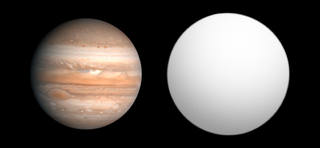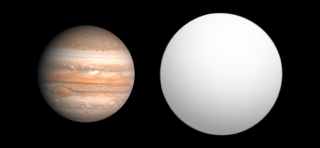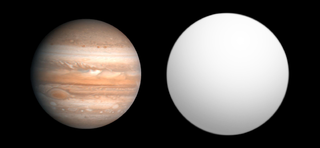
TrES-1b is an extrasolar planet approximately 523 light-years away in the constellation of Lyra. The planet's mass and radius indicate that it is a Jovian planet with a similar bulk composition to Jupiter. Unlike Jupiter, but similar to many other planets detected around other stars, TrES-1 is located very close to its star, and belongs to the class of planets known as hot Jupiters. The planet was discovered orbiting around GSC 02652-01324.

OGLE-TR-122 is a binary stellar system containing one of the smallest main-sequence stars whose radius has been measured. It was discovered when the Optical Gravitational Lensing Experiment (OGLE) survey observed the smaller star eclipsing the larger primary. The orbital period is approximately 7.3 days. The system's primary is thought to resemble the Sun.
OGLE-TR-111 is a yellow dwarf star approximately 5,000 light-years away in the constellation of Carina. Having an apparent magnitude of about 17, this distant and dim star has not yet been cataloged. Because its apparent brightness changes when one of its planets transits, the star has been given the variable star designation V759 Carinae.

OGLE-TR-10 is a distant, magnitude 16 star in the constellation of Sagittarius. It is located near the Galactic Center. This star is listed as an eclipsing type variable star with the eclipse due to the passage of the planet as noted in the discovery papers.
OGLE-TR-132 is a distant magnitude 15.72 star in the star fields of the constellation Carina. Because of its great distance, about 4,900 light-years, and location in the crowded field it was not notable in any way. Because its apparent brightness changes when one of its planets transits, the star has been given the variable star designation V742 Carinae. The spectral type of the star is type F. A yellow-white, very metal-rich dwarf star, it is slightly hotter and more luminous than the Sun.

OGLE-TR-10b is an extrasolar planet orbiting the star OGLE-TR-10.
OGLE-TR-56 is a dim, distant, magnitude 17 Sun-like star located approximately 1,500 parsecs away in the constellation of Sagittarius. This star is listed as an eclipsing type variable star with the eclipse due to the passage of the planet as noted in the discovery papers.

OGLE-TR-56b is an extrasolar planet located approximately 1500 parsecs or 5000 light years away in the constellation of Sagittarius, orbiting the star OGLE-TR-56. This planet was the first known exoplanet to be discovered with the transit method. The object was discovered by the OGLE project, announced on July 5, 2002 and confirmed on January 4, 2003 by the Doppler technique. The period of this confirmed planet was the shortest until the confirmed discovery of WASP-12b on April 1, 2008. The short period and proximity of the OGLE-TR-56 b to its host mean it belongs to a class of objects known as hot Jupiters.

TrES-2b is an extrasolar planet orbiting the star GSC 03549-02811 located 750 light years away from the Solar System. The planet was identified in 2011 as the darkest known exoplanet, reflecting less than 1% of any light that hits it. The planet's mass and radius indicate that it is a gas giant with a bulk composition similar to that of Jupiter. Unlike Jupiter, but similar to many planets detected around other stars, TrES-2b is located very close to its star and belongs to the class of planets known as hot Jupiters. This system was within the field of view of the Kepler spacecraft.
OGLE-TR-113 is a dim, distant magnitude 16 binary star in the star fields of the constellation Carina. Because of its distance of about 1170 light years, and location in a crowded field it was not notable in any way. Its apparent brightness changes when one of its planets transits, so the star has been given the variable star designation V752 Carinae. Spectral type of the star is type K dwarf star, slightly cooler and less luminous than the Sun.
OGLE-TR-182 is a dim magnitude 17 star far off in the constellation Carina at a distance of approximately 12,700 light years.
OGLE-TR-211 is a distant magnitude 14 star located about 5,700 light years away in the constellation of Carina.

WASP-11b/HAT-P-10b or WASP-11Ab/HAT-P-10Ab is an extrasolar planet discovered in 2008. The discovery was announced by press release by the SuperWASP project in April 2008 along with planets WASP-6b through to WASP-15b, however at this stage more data was needed to confirm the parameters of the planets and the coordinates were not given. On 26 September 2008, the HATNet Project's paper describing the planet which they designated HAT-P-10b appeared on the arXiv preprint server. The SuperWASP team's paper appeared as a preprint on the Extrasolar Planets Encyclopaedia on the same day, confirming that the two objects were in fact the same, and the teams agreed to use the combined designation.

OGLE-TR-211b is a transiting planet in Carina constellation. Its radius is about 36% more than Jupiter and has mass 3% more than Jupiter, which is considered an “inflated Hot Jupiter”. The planet takes 3.7 days at about the same distance as 51 Pegasi b orbits around 51 Pegasi.

OGLE-TR-113b is an extrasolar planet orbiting the star OGLE-TR-113.

OGLE2-TR-L9b is an extrasolar planet discovered by three undergraduate students from Leiden University, Netherlands. The planet is about 4.5 times as massive as Jupiter and is the first discovered planet orbiting a fast-rotating hot star.

OGLE2-TR-L9 is a magnitude 15 star in the constellation Carina at a distance of approximately 5,142 light years.

OGLE-TR-111b is an extrasolar planet approximately 5,000 light-years away in the constellation of Carina. The planet is currently the only confirmed planet orbiting the star OGLE-TR-111.

OGLE-TR-132b is an extrasolar planet orbiting the star OGLE-TR-132.
HAT-P-13, also known as GSC 03416-00543, is a G-type main sequence star approximately 811 light-years away in the constellation Ursa Major. In 2009 it was discovered that this star is orbited by two massive planets, the innermost of which transits the star. This was the first known example of an extrasolar transiting planet with an additional planet in the same system.













